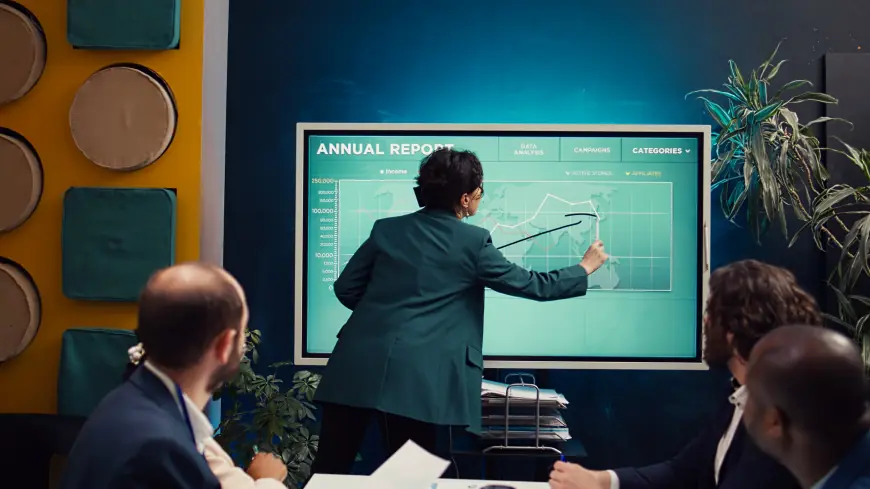The Do’s and Don’ts of Animation in Presentations
In the realm of presentation design UAE, animation plays a critical role in shaping audience engagement and enhancing the message delivery.

Animation, when used effectively, can direct attention, emphasize important content, and create a professional tone. However, when overused or misapplied, it can distract, confuse, or even annoy the audience. For businesses and professionals in the UAE—where presentation standards are often high due to international exposure and competition—knowing how to strike the right balance is essential.
Whether you're preparing a corporate pitch in Dubai, a government proposal in Abu Dhabi, or a sales deck in Sharjah, understanding the do’s and don’ts of using animation will help you elevate your slides while maintaining a polished and purposeful appearance.
Do: Use Animation to Guide Attention
One of the main functions of animation is to guide your audience’s eyes to the key elements of your slide. In a region like the UAE, where multilingual and multicultural audiences are common, it's especially important to direct attention carefully so that your message is understood clearly. For example, using a simple “fade-in” effect to introduce bullet points one at a time can help keep your audience focused on each idea without overwhelming them with too much information at once.
The key is subtlety. A good presentation designer in UAE markets would know how to time animations just right to match the speaker’s rhythm. Proper sequencing keeps the narrative controlled and digestible.
Don’t: Overload Slides with Flashy Effects
While it may be tempting to show off the full range of animation options available in PowerPoint or Keynote, excessive animations often lead to visual clutter. Spinning, bouncing, or zooming elements can quickly become a distraction and may give off an amateurish impression. This is especially true in the UAE’s business environment, where professionalism is highly valued.
When clients or executives are expecting a sleek and sophisticated UAE presentation design, a barrage of exaggerated motion effects can undermine the content. Remember, animation should support your message, not overshadow it.
Do: Keep Transitions Consistent
Consistency is a hallmark of good design. That includes the way you handle transitions between slides. Choose a single style, such as a simple “fade” or “push,” and apply it throughout your entire deck. This keeps the presentation flowing smoothly and prevents jarring or disjointed experiences.
Consistency is particularly important when presenting in formal settings like government bodies or investment boards across the UAE, where visual harmony reflects brand strength and strategic clarity. A polished presentation that maintains consistent animation effects shows attention to detail and reinforces trust.
Don’t: Use Different Animations on Every Slide
Nothing screams disorganized more than a presentation where every slide has a different animation style. It distracts the audience and suggests a lack of a unified design direction. Imagine pitching to potential investors in Dubai and your deck has slides flipping, zooming, and flying in all directions—it’s not going to impress anyone.
Whether you're crafting a training seminar or a business proposal, the priority in presentation design across UAE industries should always be clarity and cohesion. Stick to one or two animation types and use them purposefully.
Do: Match Animation Timing with Your Speech
Great presentations are like performances. Just as a performer times their lines with gestures, your animations should be timed to match the pace of your narration. If you’re speaking about a process, have each step appear in sync with your explanation. This creates a rhythm that holds the audience’s attention and enhances comprehension.
This approach is especially useful in technical or data-driven presentations, which are common in sectors like energy, finance, and construction in the UAE. A well-timed build-up using animations can simplify complex processes and keep audiences engaged without overwhelming them.
Don’t: Let Animation Slow You Down
One of the worst things you can do is create animations that delay your presentation unnecessarily. Long transitions, slow motion paths, or delays between elements can irritate your audience and make your presentation feel sluggish.
In fast-paced business environments like those in the UAE, time is often limited. Stakeholders appreciate efficiency. If your animation is making your presentation take longer than necessary, consider trimming or removing it entirely.
Do: Use Animation to Highlight Key Messages
Animation is a powerful tool for emphasis. If there's a particular point you want your audience to remember—such as a major statistic, a deadline, or a call to action—animation can help draw attention to it.
For instance, using a highlight animation or a subtle glow on a key phrase can make it stand out from the rest of the slide. In UAE presentation design, where standing out in a competitive business climate is important, this kind of controlled emphasis can be a valuable asset.
Don’t: Animate for the Sake of It
Every element of your presentation should serve a purpose, and this includes animation. Ask yourself: Does this animation help clarify the message? Does it support audience engagement? If the answer is no, it’s better left out.
One common mistake seen in presentations across various UAE industries is animation used just because the designer thought it “looked cool.” This often backfires by distracting from the content or making the design feel unprofessional.
Do: Consider Cultural Expectations
When designing presentations in the UAE, it’s essential to consider cultural sensitivities and preferences. The UAE business community is diverse and includes professionals from Europe, Asia, the Middle East, and beyond. What works in one region may not be appropriate in another.
For example, extremely flashy animations might be acceptable in some Western advertising pitches but could appear inappropriate or unrefined in more formal Emirati boardroom settings. A well-versed presentation specialist in UAE markets will know how to tailor animation styles based on the cultural and industry context.
Don’t: Forget Mobile and Online Viewers
More presentations in the UAE are being shared online or delivered via virtual platforms. If your presentation is likely to be viewed on a tablet, smartphone, or remote screen, it’s important to test your animations on these platforms.
Heavy animation might not render properly or could cause delays in video conferencing tools, especially if viewers have limited bandwidth. In these cases, minimal animation with emphasis on clarity is best.
Do: Test Your Presentation Thoroughly
Always review your animations before going live. Check if everything works as expected. Make sure animations aren’t overlapping or causing delays. Practice your delivery with the animations in place to ensure timing is natural.
In the UAE, where high-stakes presentations to investors, government officials, and corporate leaders are common, rehearsing with animations is not just advisable—it’s essential. A smooth, well-rehearsed presentation can make a strong impression, while a glitchy or poorly-timed one can hurt your credibility.
Don’t: Assume More is Better
The biggest takeaway about animation in presentation design is this: More is not always better. Use it thoughtfully, sparingly, and strategically. The best presentations in UAE boardrooms and conferences often feature clean, elegant slides that use minimal animation to drive points home.
Animation should serve as an aid, not a crutch. If your content can’t stand on its own, animation won’t save it. But when you have strong content and you enhance it with purposeful motion, that’s when your presentation truly shines.
Conclusion
Animation can either elevate or undermine your message. In the fast-paced, multicultural, and competitive business environment of the UAE, knowing how to use animation effectively is a critical part of modern presentation design.
From guiding attention to emphasizing key points, animation has the potential to make your message more compelling. But it’s also easy to misuse. By sticking to these do’s and don’ts, professionals across the Emirates can ensure that their presentations are not only visually engaging but also respectful of the audience’s time and expectations.
Whether you're designing in Dubai, Abu Dhabi, or Sharjah, focus on clarity, consistency, and cultural sensitivity. Keep animation elegant, purposeful, and always in service of your message. That’s how you succeed in delivering high-impact, professional presentations that resonate across the UAE.
What's Your Reaction?
 Like
0
Like
0
 Dislike
0
Dislike
0
 Love
0
Love
0
 Funny
0
Funny
0
 Angry
0
Angry
0
 Sad
0
Sad
0
 Wow
0
Wow
0


















































